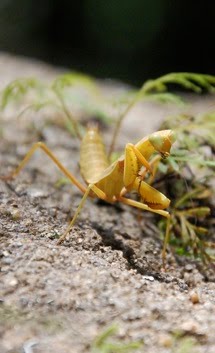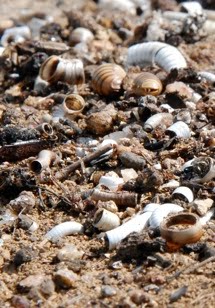When taking kids on a field trip, it is always best to do a head count. But since I took the 3rd, 4th and 5th graders from Akany Avoko to a crocodile farm, I thought it best to be thorough and do hand, finger, foot and toe counts too. And when all was said and done, we were all accounted for down to the very last toe.
And what did the excited Malagasy students learn at the crocodile farm? Well, why don't you tag along for a virtual field trip and find out?
Right, welcome to the Croc Farm. Make sure to stick with your buddy and no sharing your sandwich with the man-eating reptiles. Last chance, anyone need to tinkle? Good, let's get started.
Crocodiles are pointy-toothed time machines. That doesn't mean you can crawl inside one and zap yourself to the future. In fact, I would advise you to never crawl inside a crocodile. (Except for perhaps you, William.) Crocodiles are like a time machine, because when you look at one you are looking backwards 200 million years!
Dinosaurs saw the same kind of crocodiles that you see. That is because crocodiles are nearly perfect reptiles. Unlike Sally's spelling, there really isn't much room for improvement. They pretty much stay the same.
Most animals and plants change over time as certain genetic mutations and features work out better than the ones their parents and grandparents had. The new slightly different animals or plants do well and have lots of babies. Do that for millions of years and things can really change. But crocodiles don't really change anymore. They made all the right adaptations a long time ago.
Yes, Timmy?
"What are some of those adaptations that make them so perfect?"
Excellent question, but please take your finger out of your nose while I answer it. Thanks.
Well, for one thing check out that long, strong tail. That puppy is chock full of muscles. It can use it to gently swim through the water or ambush a poor defenseless bird that was just trying to have a little drink. Poor bird.
Their fat webbed feet aren't used for paddling. They are used to steer and to support their body as they walk, run and even hop on land. No small feat considering a large crocodile can weigh as much as a car.
They don't hunt down their food. They use their excellent camouflage (and patience) to wait for food to come just a bit too close before they ambush it and bite down with their world famous jaws.
A crocodile can really bite. I know Ruby, your little sister can really bite too, but she is nothing compared to a crocodile. Their bite is 5,000 pounds per square inch. Yeah, what does that mean. I get it. Well, let's compare it to another toothsome foe, the great white shark. That seal-eating super fish can only chomp down with a measly 400 pounds per square inch.
But with all those big muscles used to bite down, there aren't many left over to open the mouth back up, so a crocodile is a bit of a weakling too. Even you could hold a crocodile's mouth shut, Pete (even though you don't seem to be able to keep your own shut for more than two seconds).
Now let's shuffle over to the next pond.
Crocodiles are cold-blooded; just like math teachers. Just kidding, Mr. Weedle. Thanks for coming today and please put down that rock. Right, you are able to eat delicious food (or the food they serve in the cafeteria) and turn that food into energy and heat. That means you are warm-blooded. You pretty much stay at 37.5 degrees Celsius. Cold-blooded animals can't really warm themselves up. They have to get some help from the sun. Their blood can get hot and cold and it doesn't really hurt them.
Crocodiles can't sweat to cool off like you. So when they get a bit past toasty, they open up their mouths to cool off like a dog. They can take a swim to cool off too. To warm up, they drag their big bellies up onto a nice beach to catch some rays and maybe eat a wildebeest.
In Madagascar, there are some special crocodiles that have learned--eyes on me, Lester--to love the cold. They are the only crocodiles in the world that live in caves. Caves are cold. That means the crocodiles are cold. And when a cold-blooded animal gets cold, they get slow. And in the Madagascar cave crocodiles' case--sorry, head up and eyes on me, Lester--they get so cold they can't even eat. They have to get out into the sun to warm up enough to have a meal. It's not too much of a hassle though. Some of them only eat once a year. And during certain times of the--right, that's it! Mr. Weedle, would you kindly pick up Lester and feed him to the crocodiles?
Thank you.
Yes, Becky?
"Why does Lester get to play with the crocodiles and the rest of us don't?"
Because I like him best. Now let's move on.
Take a close look at the crocodile skin. It may look old, rough and clunky, but it's really top-of-the-line high-tech stuff. It has special receptors that allow it to feel even the tiniest movement in the water. And the scales are so tough and protective that some tribes in Africa even used the skin as shields. A crocodile's armored outer shell even helps on chilly mornings. There are thousands and thousands of small capillaries running with blood just beneath the thick bits. The scales absorb the sun's heat and transfer it to the blood. Nifty, no?
Simon?
"This is getting boring?"
Simon, you're getting an F for today, but you don't see me complaining do you?
Fine, I'll shut my trap about the wonderful world of crocodiles and we'll see what else the Croc Farm has to offer.
"Mr. Lebo, the ostrich looks angry."
Oh, it's probably just upset, because it can't fly. Or that it's so far from home. Ostriches never lived in Madagascar. They did have elephant birds though and they were almost twice as tall.
Here, you can see two very special turtles who appear to be in love or involved in some sort of turtle car accident. The little one in the midst of being run over is a radiated tortoise. One of them lived to be 188 years old making it the oldest known living animal. And the big one doing the running over is a Seychelles giant tortoise and it is one of the largest tortoises in the world. Madagascar used to be crawling with similar giant tortoises, but they became extinct shortly after people arrived about 2,500 years ago.
"Mr. Lebo, why would people be so mean to big lovable turtles?"
I don't know. Maybe because they asked too many questions.
Alright, that's it for blabbing. It's time for some fun. Take off your shoes and you can each have eleven seconds to enjoy the bounce and wonder of the trampoline...................... ...................................Excellent, fun is over.

"But you said we could have ice cream?"
I also said you wouldn't have homework this weekend. Do you believe everything I say?
Oh, for goodness sakes, stop crying or you can all go help Lester wrestle the crocodile.
"I almost got her, Mr. Lebo! Ouch. I think she's getting tired. Ow! Pointy teeth. So many pointy teeth. Ow!"
Good work, Lester. Now, while the crocodile finishes her snack, we can all go have some ice cream...if it will keep you from whining.

"Thank you, Mr. Lebo!"
Yeah, yeah.

Ok, it's the real Mr. Lebo here. Not the mean one from the virtual field trip we just took. I just want to let you know that the real thanks don't go to me. They go to Mrs. Schwimmer in Princeton, NJ for being ever so kind and loving by donating her own birthday money to help send the kids from Akany Avoko on a wonderful, wonderful field trip to the quite real Croc Farm. And, yes, we did get ice cream on the way home. And, no, none of the kids spilled it all over their nice clean shirts. I was the only one to do that.

If you are interested in sending the kids of Akany Avoko children's home on another cool field trip, please email me at chad_lebo@monet.prs.k12.nj.us to find out how.
 Some animals just get all the attention. And in Madagascar, this is the animal that has stolen the show. Everyone wants to see ring-tailed lemurs. Hundreds or different frogs. More chameleons than any place on earth. Insects that look like aliens designed them. Thousands of strange and wonderful plants. But no, everyone wants to see King Julian and his ring-tailed buddies.
Some animals just get all the attention. And in Madagascar, this is the animal that has stolen the show. Everyone wants to see ring-tailed lemurs. Hundreds or different frogs. More chameleons than any place on earth. Insects that look like aliens designed them. Thousands of strange and wonderful plants. But no, everyone wants to see King Julian and his ring-tailed buddies. 
































